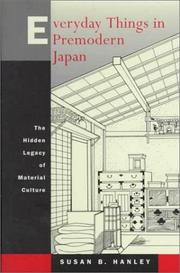| Listing 1 - 9 of 9 |
Sort by
|

ISBN: 0520204700 0520218124 Year: 1999 Publisher: Berkeley University of California press
Abstract | Keywords | Export | Availability | Bookmark
 Loading...
Loading...Choose an application
- Reference Manager
- EndNote
- RefWorks (Direct export to RefWorks)
Japan was the only non-Western nation to industrialize before 1900 and its leap into the modern era has stimulated vigorous debates among historians and social scientists. In an innovative discussion that posits the importance of physical well-being as a key indicator of living standards, Susan B. Hanley considers daily life in the three centuries leading up to the modern era in Japan. She concludes that people lived much better than has been previously understood--at levels equal or superior to their Western contemporaries. She goes on to illustrate how this high level of physical well-being had important consequences for Japan's ability to industrialize rapidly and for the comparatively smooth transition to a modern, industrial society. While others have used income levels to conclude that the Japanese household was relatively poor in those centuries, Hanley examines the material culture--food, sanitation, housing, and transportation. How did ordinary people conserve the limited resources available in this small island country? What foods made up the daily diet and how were they prepared? How were human wastes disposed of? How long did people live? Hanley answers all these questions and more in an accessible style and with frequent comparisons with Western lifestyles. Her methods allow for cross-cultural comparisons between Japan and the West as well as Japan and the rest of Asia. They will be useful to anyone interested in the effects of modernization on daily life.
Material culture --- Culture matérielle --- Japan --- Japon --- Social life and customs --- History --- Moeurs et coutumes --- Histoire --- J4150 --- J4140.60 --- Japan: Sociology and anthropology -- customs, folklore and culture --- Japan: Sociology and anthropology -- cultural history -- Kinsei, Edo, Tokugawa period, early modern (1600-1867) --- Social life and customs. --- J4150.60

ISBN: 0520922670 0585101477 9780520922679 9780585101477 9780520204706 0520204700 0520218124 9780520218123 0520204700 Year: 1997 Publisher: Berkeley, Calif. University of California Press
Abstract | Keywords | Export | Availability | Bookmark
 Loading...
Loading...Choose an application
- Reference Manager
- EndNote
- RefWorks (Direct export to RefWorks)
Japan was the only non-Western nation to industrialize before 1900 and its leap into the modern era has stimulated vigorous debates among historians and social scientists. In an innovative discussion that posits the importance of physical well-being as a key indicator of living standards, Susan B. Hanley considers daily life in the three centuries leading up to the modern era in Japan. She concludes that people lived much better than has been previously understood--at levels equal or superior to their Western contemporaries. She goes on to illustrate how this high level of physical well-being had important consequences for Japan's ability to industrialize rapidly and for the comparatively smooth transition to a modern, industrial society. While others have used income levels to conclude that the Japanese household was relatively poor in those centuries, Hanley examines the material culture--food, sanitation, housing, and transportation. How did ordinary people conserve the limited resources available in this small island country? What foods made up the daily diet and how were they prepared? How were human wastes disposed of? How long did people live? Hanley answers all these questions and more in an accessible style and with frequent comparisons with Western lifestyles. Her methods allow for cross-cultural comparisons between Japan and the West as well as Japan and the rest of Asia. They will be useful to anyone interested in the effects of modernization on daily life.
Material culture --- Gender & Ethnic Studies --- Social Sciences --- Ethnic & Race Studies --- Japan --- Social life and customs. --- History --- anthropology. --- asia. --- asian history. --- asian studies. --- consumption. --- cultural history. --- daily diet. --- economics. --- ethnic studies. --- food studies. --- food. --- furnishings. --- health. --- history. --- housing. --- human waste. --- hygiene. --- industrialization. --- irori. --- japan. --- japanese history. --- kamado. --- kosode. --- living standards. --- material culture. --- meiji. --- nonfiction. --- politics. --- premodern japan. --- quality of life. --- sanitation. --- shoin. --- social history. --- tokugawa. --- transportation. --- urban sanitation. --- wellness. --- world history.
Book
ISBN: 0691031118 0691100551 0691643792 0691616507 1400869374 9780691100555 9780691031118 Year: 1977 Publisher: Princeton Princeton university press
Abstract | Keywords | Export | Availability | Bookmark
 Loading...
Loading...Choose an application
- Reference Manager
- EndNote
- RefWorks (Direct export to RefWorks)
According to the Marxist interpretation still dominant in Japanese studies, the last century and a half of the Tokugawa period was a time of economic and demographic stagnation. Professors Hanley and Yamamura argue that a more satisfactory explanation can be provided within the framework of modem economic theory, and they advance and test three important new hypotheses in this book.The authors suggest that the Japanese economy grew throughout the Tokugawa period, though slowly by modern standards and unevenly. This growth, they show, tended to exceed the rate of population increase even in the poorer regions, thus raising the living standard despite major famines. Population growth was controlled by a variety of methods, including abortion and infanticide, for the primary purpose of raising the standard of living. Contrary to the prevailing view of scholars, thus, the conclusions advanced here indicate that the basis for Japan's rapid industrialization in the Meiji period was in many ways already established during the latter part of the Tokugawa period. The authors' analysis combines original fieldwork with study of data based on findings of the postwar years.Originally published in 1978.The Princeton Legacy Library uses the latest print-on-demand technology to again make available previously out-of-print books from the distinguished backlist of Princeton University Press. These editions preserve the original texts of these important books while presenting them in durable paperback and hardcover editions. The goal of the Princeton Legacy Library is to vastly increase access to the rich scholarly heritage found in the thousands of books published by Princeton University Press since its founding in 1905.
Japan --- Japon --- Economic conditions --- Population --- History --- Conditions économiques --- Histoire --- 330.35 --- 314.1 --- J4330 --- J4300.60 --- Economische groei. Kwantitatieve toename. Technische vooruitgang --zie ook {338.09} --- Algemene demografische vraagstukken --- Japan: Economy and industry -- demography, population theory --- Japan: Economy and industry -- history -- Kinsei, Edo, Tokugawa period, early modern (1600-1867) --- -Population --- -History. --- 314.1 Algemene demografische vraagstukken --- 330.35 Economische groei. Kwantitatieve toename. Technische vooruitgang --zie ook {338.09} --- Conditions économiques --- Nihon --- Nippon --- Iapōnia --- Zhāpān --- I︠A︡ponii︠a︡ --- Yapan --- Japão --- Japam --- Mư̄ang Yīpun --- Prathēt Yīpun --- Yīpun --- Jih-pen --- Riben --- Government of Japan --- 日本 --- 日本国 --- Nipponkoku --- Nippon-koku --- Nihonkoku --- Nihon-koku --- State of Japan --- Япония --- Japani --- اليابان --- al-Yābān --- يابان --- Yābān --- Japonsko --- Giappone --- Japonia --- Japonya --- History. --- Bevölkerung. --- Economic history. --- Population Dynamics --- Population. --- Socioeconomic Factors --- Wirtschaft. --- HISTORY / Asia / Japan. --- Human population --- Human populations --- Population growth --- Populations, Human --- Economics --- Human ecology --- Sociology --- Demography --- Malthusianism --- History, Economic --- Japan - Economic conditions - To 186. --- Japan - Population - History --- Jepun --- Yapon --- Yapon Ulus --- I︠A︡pon --- Япон --- I︠A︡pon Uls --- Япон Улс
Book
Abstract | Keywords | Export | Availability | Bookmark
 Loading...
Loading...Choose an application
- Reference Manager
- EndNote
- RefWorks (Direct export to RefWorks)
Book
ISBN: 9781400869374 Year: 2015 Publisher: Princeton, NJ
Abstract | Keywords | Export | Availability | Bookmark
 Loading...
Loading...Choose an application
- Reference Manager
- EndNote
- RefWorks (Direct export to RefWorks)
Book
ISBN: 0321700759 9780321700759 Year: 2011 Publisher: Upper Saddle River, NJ Addison-Wesley
Abstract | Keywords | Export | Availability | Bookmark
 Loading...
Loading...Choose an application
- Reference Manager
- EndNote
- RefWorks (Direct export to RefWorks)

ISBN: 0804712328 Year: 1985 Publisher: Stanford (Calif.): Stanford university press
Abstract | Keywords | Export | Availability | Bookmark
 Loading...
Loading...Choose an application
- Reference Manager
- EndNote
- RefWorks (Direct export to RefWorks)
Families --- Fertility, Human --- Marriage age --- History --- China --- Japan --- Population
Book

ISBN: 0691102457 140085430X 0691604843 0691054592 1306989795 0691633851 9780691604848 9781400854301 Year: 2014 Publisher: Princeton, NJ
Abstract | Keywords | Export | Availability | Bookmark
 Loading...
Loading...Choose an application
- Reference Manager
- EndNote
- RefWorks (Direct export to RefWorks)
In this book social scientists scrutinize the middle decades of the nineteenth century in Japan. That scrutiny is important and overdue, for the period from the 1850s to the 1880s has usually been treated in terms of politics and foreign relations. Yet those decades were also of pivotal importance in Japan's institutional modernization. As the Japanese entered the world order, they experienced a massive introduction of Western-style organizations. Sweeping reforms, without the class violence or the Utopian appeal of revolution, created the foundation for a modern society. The Meiji Restoration introduced a political transformation, but these chapters address the more gradual social transition.Originally published in 1986.The Princeton Legacy Library uses the latest print-on-demand technology to again make available previously out-of-print books from the distinguished backlist of Princeton University Press. These editions preserve the original texts of these important books while presenting them in durable paperback and hardcover editions. The goal of the Princeton Legacy Library is to vastly increase access to the rich scholarly heritage found in the thousands of books published by Princeton University Press since its founding in 1905.
Japan -- History -- 19th century. --- Japan -- History -- Meiji period, 1868-1912. --- Japan -- Social conditions -- 1868-. --- Japan --- History --- Social conditions --- J3367 --- J3371 --- Japan: History -- Kinsei, Edo period -- kaikoku and bakumatsu (1853-1867) --- Japan: History -- Kindai, modern -- Meiji period (1868-1912) --- Japon --- Histoire --- Conditions sociales --- Japon. Histoire. 1850-1880. --- Japan. Geschiedenis. 1850-1880. --- Social conditions. --- 1800-1912. --- Japan. --- SOCIAL SCIENCE / General.
Book

ISBN: 9781400855315 Year: 2014 Publisher: Princeton, NJ
Abstract | Keywords | Export | Availability | Bookmark
 Loading...
Loading...Choose an application
- Reference Manager
- EndNote
- RefWorks (Direct export to RefWorks)
| Listing 1 - 9 of 9 |
Sort by
|

 Search
Search Feedback
Feedback About UniCat
About UniCat  Help
Help News
News